|
Wood pellets (for fuel)
Click
here
for charts illustrating each EU member state's monthly imports and
exports of wood pellets.
Click
here for a related commentary on EU member states' trade in wood
pellets.
Click
here for a summary of the share
price performance of
Drax and
Enviva Biomass.
Click
here for charts which illustrate
trade in methane
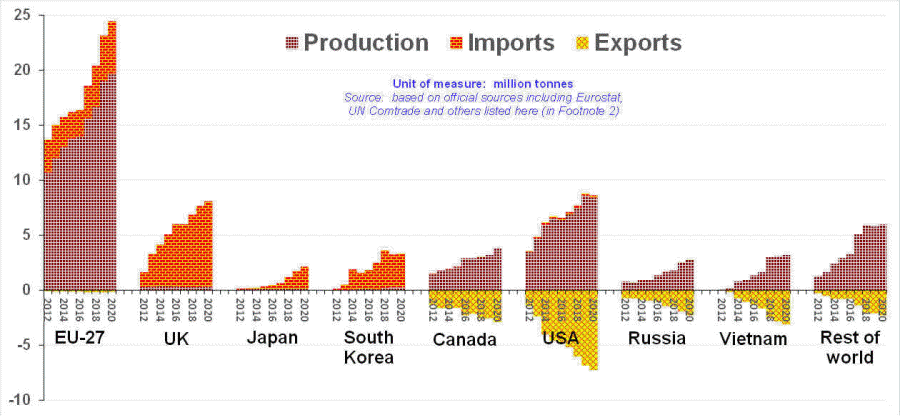
Global production, imports and exports
Sources based on:
[Production] FAOSTAT; [Imports and Exports]
official national statistics and UN Comtrade (footnote
2)
Three countries and the EU account for almost all imports, three countries outside the EU supplied almost all those (2023) imports. Three countries and the EU produced a large majority of the 2023 world total
- and exported almost all their production. The market is
clearly geographically narrow. It is also dependent on a single
sector - except in Japan, a small number of power stations (typically
large and formerly coal-fired) burn imported wood pellets to generate
subsidies. Data for 2024 suggest that the market has peaked -
even in Japan. Industrial markets - which would not be
subsidised - are unlikely to convert from fossil fuel to wood pellets,
or to use pellets as a raw material for chemicals. Others take a
different view - for example
here (page 11).
Enviva's bankruptcy demonstrates how risky
investment in production is. With costs rising and the
industry's claims to be a climate panacea increasingly recognised as
bogus, including within government, Enviva's
rebirth
may be short-lived.

Exporting countries' exports by destination
(Based on various official
sources [Footnote
2])
 Importing countries'
imports (Based on various
official sources [Footnote
2]) Importing countries'
imports (Based on various
official sources [Footnote
2])

Drax' biomass feedstock
Source: based on
Drax plc Annual Reports (various years).
5.8 million tonnes of imported wood pellets burned at Drax
during 2023
Note
1: "low grade roundwood" may be a euphemism for logs from trees
of no commercial interest to sawmills, perhaps deriving from clear felling (self-evidently unsustainable).
This proportion supplied under this category is increasing.
Note 2: "sawdust and saw mill residues" might include roundwood delivered to a sawmill which the mill does not transform.
Sawmilling and related clear felling and thinning would be less
commercially viable if pellet mills do not procure this category of
feedstock. The carbon emissions associated with this should be
attributed to the pellets, pro rata, based on weight of
sawmill output
(not commecial
value).
Latvia is a leading supplioer of sawnwood to the
UK and the UK is a leading destination for Latvia's exports of
sawnwoood.
As such, the UK is a leading contributor to Latvia's
forest land becoming a net carbon source.
Increasing the amount
of logging (implicitly cleaf-felling) to supply feedstock for the
pellets from Latvia burned at Drax compounds this.
No
compensation is yet paid by the UK (or Drax) for the net amount of
sequestration and other carbon which is foregone or lost over the
lifecycle of the affected forest.

Wood pellets supplied by Drax companies
versus what is burned at Drax
Source: based on
Drax plc Annual Reports (various years).
Time
lags aside, between 2013 and 2022, the weight burned at Drax has
matched the weight which Canada's export statistics indicate were
exported to the UK from British Columbia (the province from which
Drax' supplies to markets world-side are likely to derive). In 2023
those exports from British Columbia amount to roughly half the amount
from Canada burned at Drax. Drax
suggest
that the proportion of its pellet production for world-wide markets
burned at Drax is small enough to justify accounting
for those
burned at Drax at the market price - not cost. This would tend
to minimise taxable profit and help increase the CfDe strike price it
secures if, perhaps contary to publiuc interest, Drax' business continues "come
what may". The UK government has
offered Drax a CfD, within constraints (below full capacity), to
support the burning of imported wood pellets at Drax power station
from (aptly) April Fool's Day 2027 to 31 03 2031

CfD-subsidised power generation at times of
great national need
Source: based on
Low Carbon Conracts Company.(to end 08 2025)
Rather than address national
need, CfD contracts negotiated with large generators for burning wood
allowed and implicitly encouraged those generators to cease using
their CfD-subsidised units, maximise their returns instead. Is
their heart really in decarbonisation of the UK power grid and the
climate emergency? Does it jeopardise their proposals to capture
post-combustion CO2?

Contracts for Difference payments to each sector
(Based on
Low
Carbon Contracts Company)

UK imports of pellets compared with UK
electricity prices
Source: [imports] based on Eurostat and
UK Trade Info
(to June 2024); Drax annual reports;
[electricity prices]
Low Carbon Contracts Company (from
31 07 2016)
Electric Insights Q1 2024 (01 01 2010 to 31 03 2024)
Weak regulation of CfD subsidies? Pellet burners (and, if incentivised
by remuneration strategy, senior executives) profiting by
generating less when prices are high - thereby worsening price spikes for
electricity (and, in turn, methane), prompting reduced heat and power
use by the poor? Almost all burned at Drax and EPH Lynemouth to
generate subsidies & to pretend zero CO2 emissions?
Does this indicate that their owners are of insufficient character to
partner with the UK in Net Zero?

UK imports of pellets from USA, weight by port
and unit import value
Source: based on
UK Trade Info
(up to 30 06 2025)
Import value per unit of weight
will vary with the mix of long-term, contracted supplies and purchases
(some speculative) on the spot market (spot prices rose steeply during
autumn 2022).
The increase in imports reflects MGT Teesside starting
to
generate electricity and the restart of
CfD-subsidised generating units at Drax and Lynemouth (whose operation
was curtailed
for prolonged periods of peak demand between 2022 and
2023).
The port of Tyne supplies up to
100% of the wood pellets which EPH Lynemouth burns - to generate
subsidies - perhaps
30,000 tonnes per week or
1.4 million tonnes per year (from 2018)
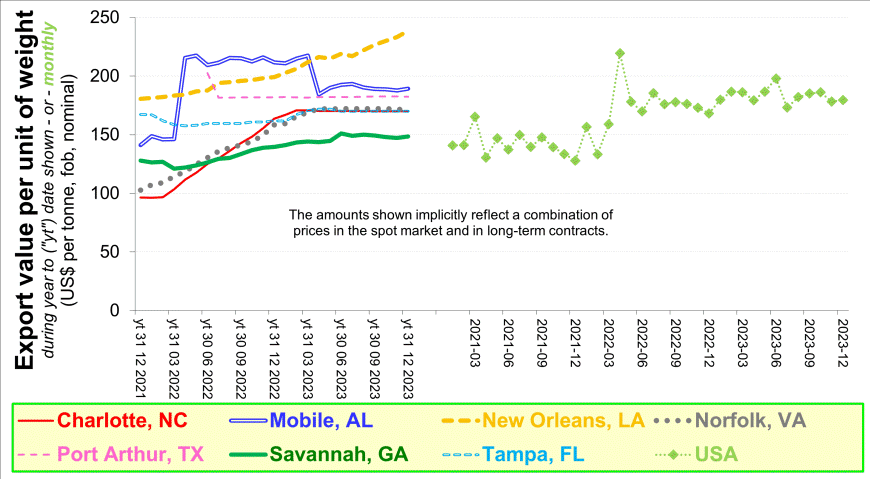
Unit
value of pellets exported from USA during spot market hiatus
Source: based on USITC Trade DataWeb
successive 12-monthy periods - 2021 to 31 07 2025
"Energy security" would tend
to have deteriorated due to the hiatus in spot market prices and
corresponding subsidy payments. The hiatus may have also
revealed the fragility of the market and corporate behaviour - as
Enviva admits in its Q3 2023 report, pellet trade contracts made at
that time might contribute to its bankruptcy. The trend shown in
the chart is upwards, jeopardising prospects for continuted subsidy. Cost cutting will tend to further erode the false veneer that regional
certification confirms sustainability and that, crucially,
burning woody biomass is
carbon neutral. UK Contracts for Difference
purportedly seek long-term decreases in price of energy delivered -
yet they seem to have risen 30% (reflecting the increase in unit
export value from $140 to $180 per tonne).
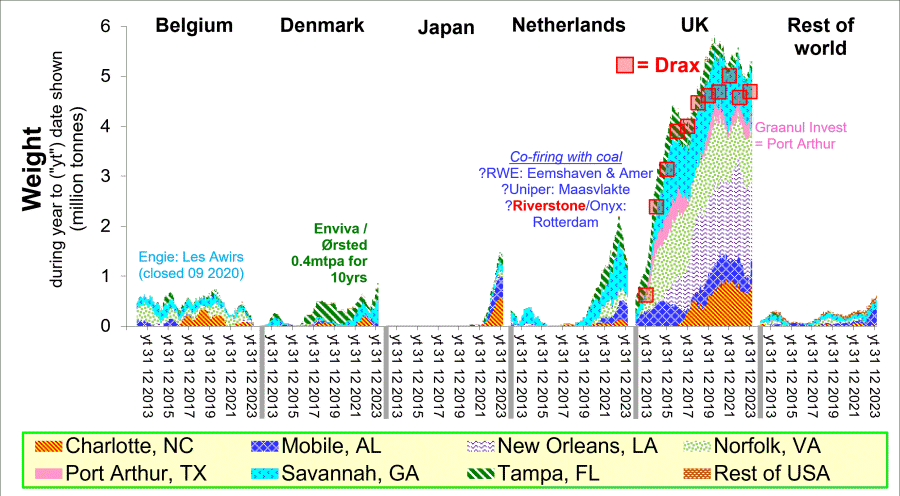
USA's exports - by customs district
(to 31 07 2025)
Source: based on USITC
Trade Dataweb (code 440131) and Drax plc publications.
Exports to all major markets except
UK in decline? UK (with c75% market share) will peak soon, as
and when all units of Drax,
Lynemouth and MGT Teesside are operating at high load factors again.
The
2022-2023 decline in exports to the UK reflects a loophole in CfD
subsidies. Instead of dispatching electricity to help overcome
shortages of methane ("natural gas") and thereby minimise acute
hardship amongst people unable to pay a surge in prices for gas and
electricity, all three biomass burning power stations did not operate
their CfD-subsidised generating units when market prices exceeded
the strike price (obliging their owners to pay government the excess
revenue the owners received).
One customer - Drax - in one country - UK - has burned most of the USA's
exports of wood pellets (and, despite a decade or so since
conversion, still heavily dependent on subsidies). Exports to Netherlands
rose and fell in step with government support. Belgium has
ceased support. Denmark's suport assumes - rashly - that
post-combustion CO2 at pellet-fired units of two power stations will
perform as proposed at a cost which will be readily accomodated (and
that that CO2 wil be permanently disposed of in Norway); Exports to Japan
are increasing rapidly - Japan copying ill-motivated UK and EU
subsidy policy. UK support has sginificantly cooled - being
offered to Drax for four years beyond the term of its current
subsidies because the cost of doing so is deemed less than reliance
on gas-fired power. This reflects recognition that burning
wood pellets (whether or not imported) has unacceptable climate
implications - and the advice of the Climate Change Committee [page
14].
The customs district of Charlotte became the customs
district of Wilmington from 01 2025.
A "regional
risk assessment" of land-use in private forests covering states in (southastern) USA was published during 2025. This
(and relaxation of regulations covering US National Forest) would have potential to influence the certification scheme which seems to serve as the de facto threshold for UK government subsidy. To be
more than box-ticking exercises, it and
other assessments and public consultations should presumably
actively seek and take fully into account input from local
stakeholders and civil society groups. There is concern about
the management of forest tracts from which feedstock for certified
pellets derive. A
class action law suit is being prepared in response to air
quality violations in the vicinity of a pellet mill. Although
many such violations have been reported for pellet mills in both
Canada and USA, these do not seem to be reflected in subsidy
eligibility criteria.
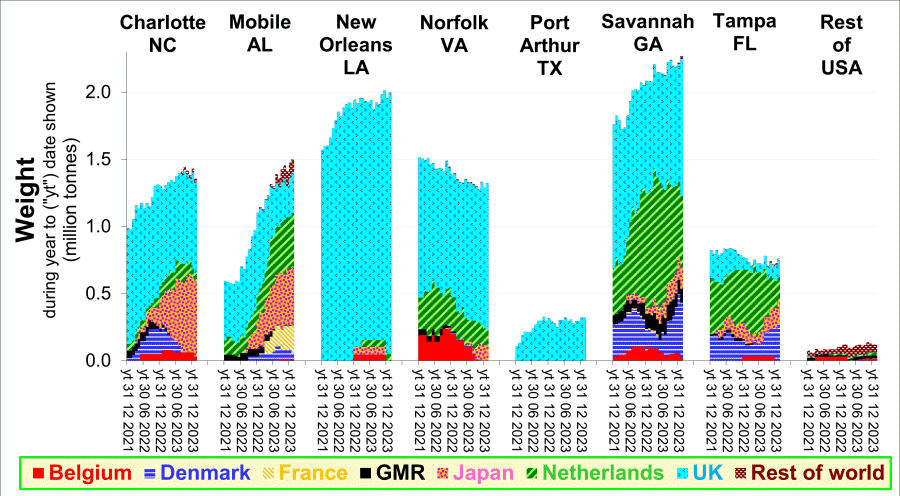 Exports
of pellets from the USA - customs distrtict by destination Exports
of pellets from the USA - customs distrtict by destination
Source: based on USITC Trade DataWeb
successive 12-monthy periods - 2021 to 31 07 2025
Rate of clear-felling (/ loss of sequestered carbon)
rising fastest in Alabama & Georgia?
Enviva (Southampton, VA) problems? Exports to leading markets in Europe
declining.
Who is burning US pellets in "France"?
"GMR" refers to Guadeloupe, Martinique and Reunion (French
territories). Albioma burns wood pellets in those territories.
"Peak pellets?"
- weight exported via each customs district either declining or at a
plateau.

Canada's exports
(to 31 08 2025)
Source: based on
Statistics
Canada (code 440131) (April and May 2024 exports to UK from BC
identical - an error?)
Is the 20%
fall in exports from BC a response to allegations about the origin
of pellets there?
The triumph of ambition (remuneration incentives
and the need to convey the appearance of momentum) over due diligence
- Drax' acquisition
of Pinnacle and subsequent expansion in BC? The steep decline in
exports from BC to UK reflects greater profit available to Drax
under its contracts with markets in Japan, than supplying Drax
power station from BC. This suggests that Drax (which
dominates pellets supply in BC, and Alberta) has a substantial competitive
advantage over Enviva in supplying those markets. During
2024, Drax
supplied almost 1.5 million
tonnes of pellets from Canada
to countries other than the UK
. Increasing costs due to wildfire (in part a consequence of
the unsustainability of supposedly sustainable forest management
practices) undermine prospects for exports of pellets from British Columbia.
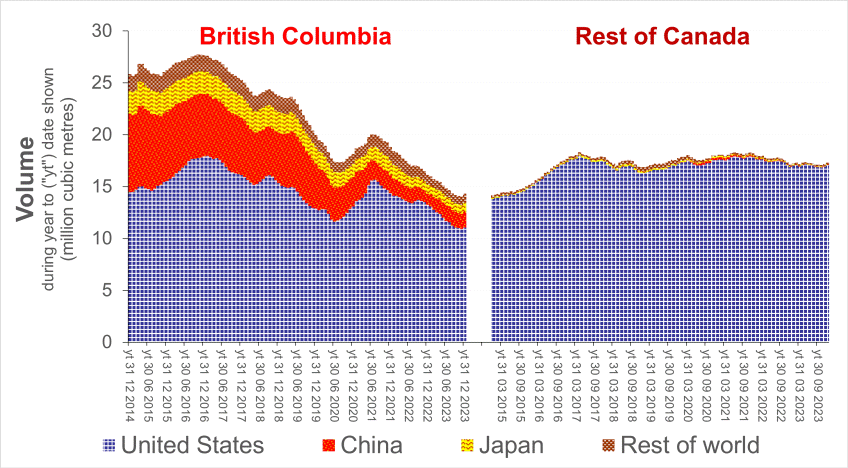
Canada's exports of sawnwood
of coniferous species
(to 31 08 2025)
Source: based on
Statistics
Canada (code 4407.1x.xx)
This chart illustrates the decline in
availability of sawmilling residues (30% since Drax acquired
Pinnacle (04 2021). Such residues are said to be the predominant
raw material in the pellets which Drax exports from British
Columbia. The pellet industry helps sustain the commercial
viability of sawmilling industries (implicitly compounding
forest-degradationa and foregone sequestration).

Canada's exports of pellets
to the UK, by province
(to 31 08 2025)
Source: based on
Statistics
Canada (code 4401.31)
Grand Valley Pellets is a leading producer of pellets in New
Brunswick; its feedstock is from
JD Irving
sawmills; it is represented on the
Standards Committee of the Sustainable Biomass Program.

EU-27 imports of pellets (& other HS4401 customs
code products)
(to 31 07 2025)
Source (based on): Eurostat
Bans against imports from Russia and Belarus helped reduce
the impact of EU27 consumption outside the EU. EU27 pellet
imports are now largely dependent on contested imports from USA,
notably Enviva (about which,
post-bankruptcy, there is a lack of market information).
Malaysia, Thailnd and Vietnam comprise most of "Other non EU-27"
imports of pellets, the great majority being imported through
France and the Netherlands.
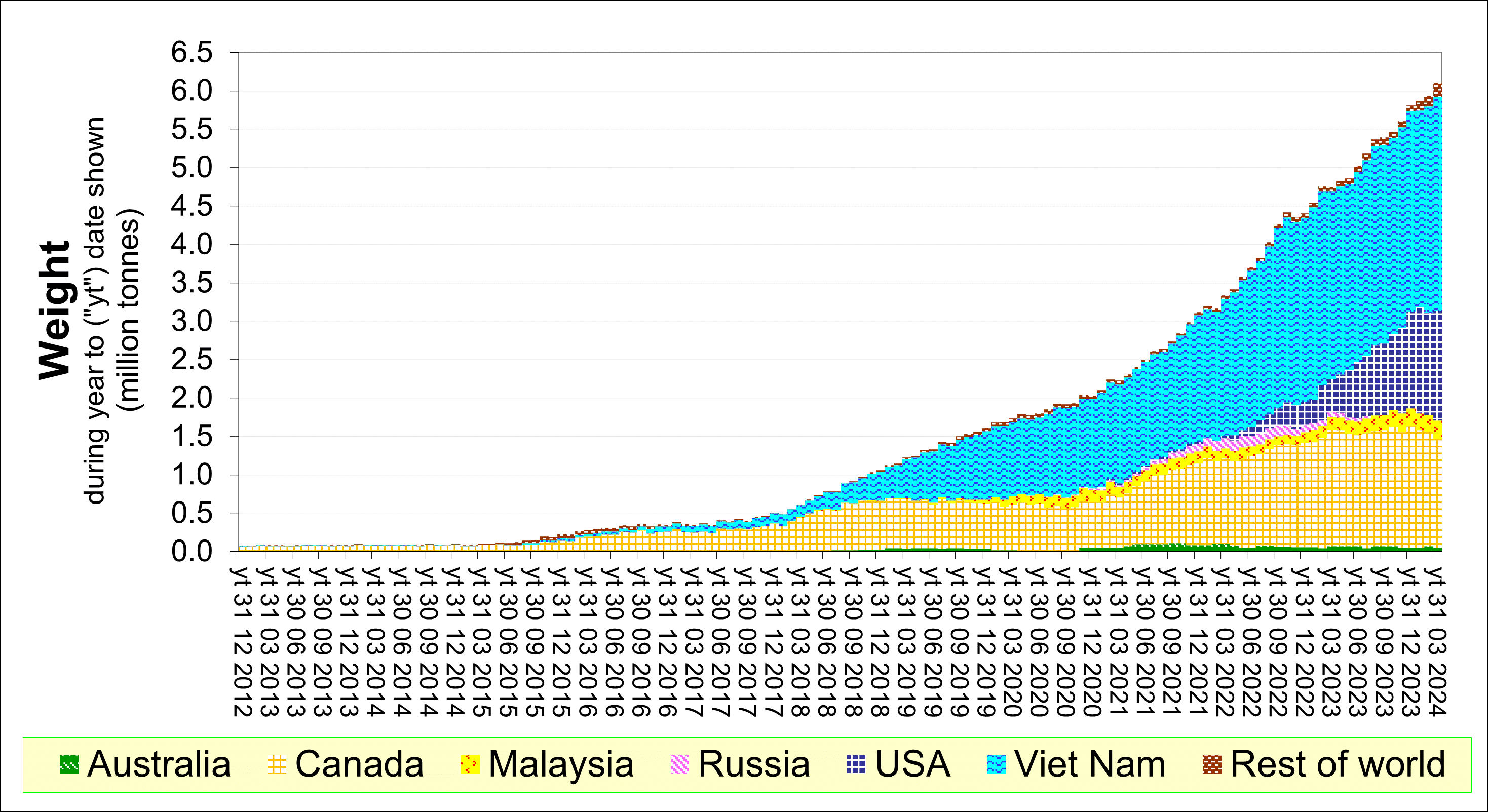
Japan's
monthly imports
Source: based on
Trade Statistics of Japan
(code 44013100) [01 01 2016 to 30 09 2025]
Heavily
dependent on a single supplying country - Viet Nam. The
increase in Japan's imports might reflect efforts to lock in
subsidies for new large power stations before these cease being
available
(commencing January 2026) and the dumping of excess feedstock
produced speculatively for export to pulp mills in China (and
perhaps Laos). Japan's risng share of Vietnam's exports
(already 70%) should be a worry for Vietnam's growers..
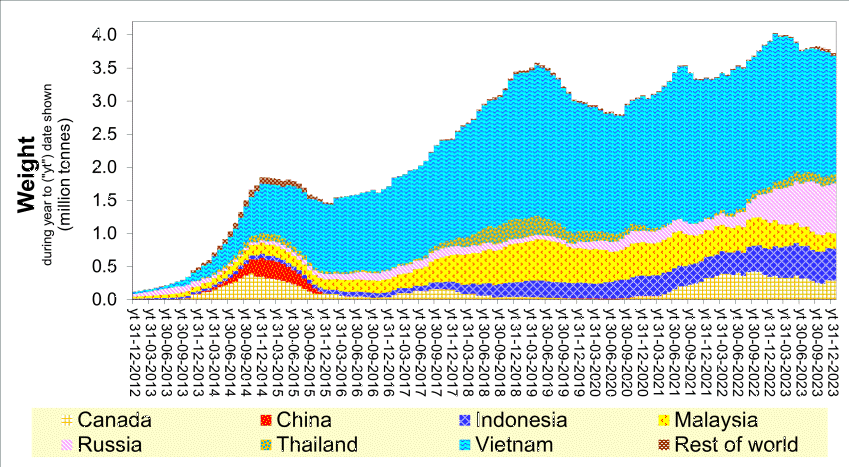
Republic
of Korea's imports
Source: based on
Korea
Customs Service (code 440131) -
to 30 09 2025
Note
step-change increase in 2022 imports from Russia and
flat current overall trend (which may significantly dampen enthusiasm
for pellet-fuelled energy in the global market).
Korea is
a world leader in
deciding to reduce support for use of wood as power station
fuel.

Republic
of Korea's imports
(- import value per unit of weight)
Source: based on
Korea
Customs Service (code 440131) -
to 30 09 2025
Note large price premium for pellets from Canada.

Taiwan's imports (- import value per unit of weight)
Source: based on
CPT Single Window - Statistics
Database Query (code 440131) -
to 30 03 2025
Interest has slumped, despite efforts by leading pellet
suppliers. The import value per unit
of weight of German pellets greatly exceeds that of pellets from Asia
- perhaps reflecting a need for quaity.
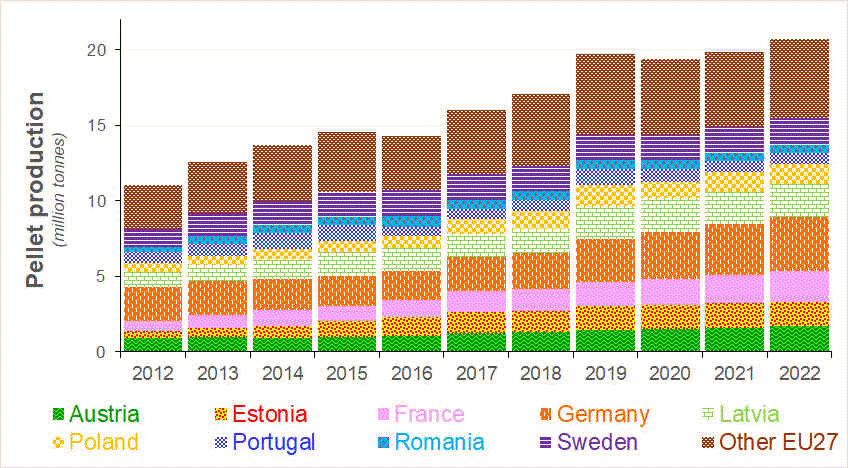
EU-27 pellet production
Source: based on
FAOSTAT
The chart above ilustrates
that production in the EU has peaked (implying an insufficiency of
viable woodland).
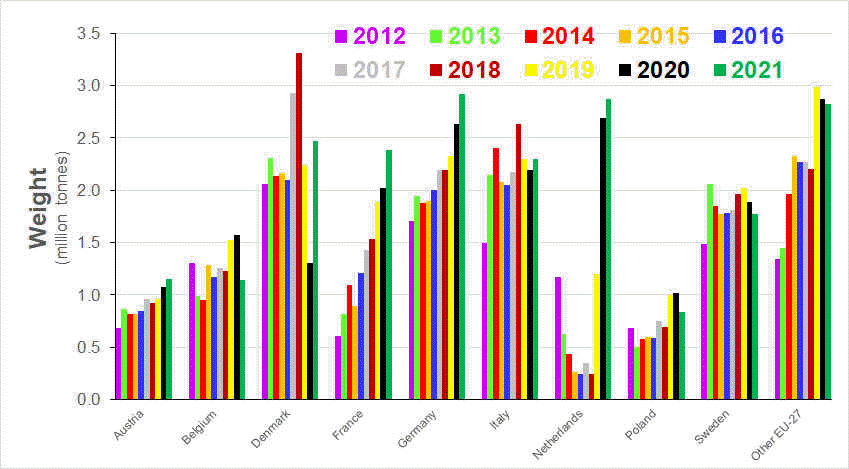
EU-27 - pellet consumption
Source: based on
FAOSTAT
(production) and
Eurostat (trade)
The FAO has provided estimates for a
number of (typically recent) years' production in several EU member states.
Strong increase in use of pellets within most EU member states -
primarily for heat. Latvia and Spain each accounted for roughly 20% of "Other EU-27"
in 2022 and 2023.

Estonia's exports of pellets, wood fuel, chips and wood residues
Source: based on
Eurostat (CN8, monthly, codes 440131, 44011*, 44012*, other
4401*) to 31 08 2025
Remarks:
Ørsted's Asnæs CHP station started burning chips
during 2020
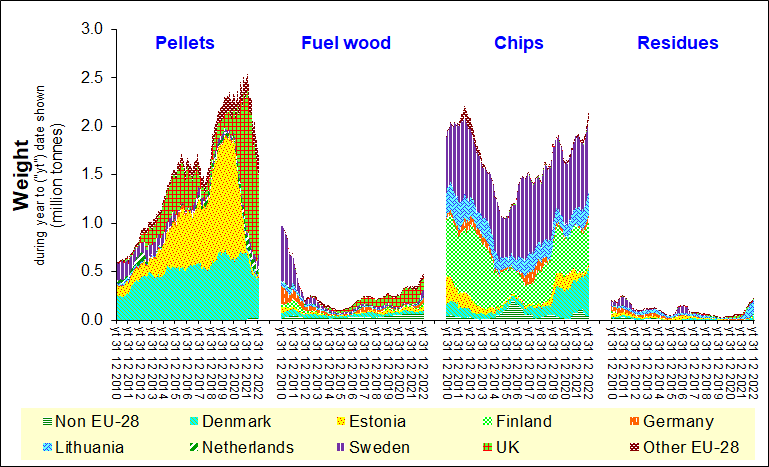
Latvia's exports of pellets, wood fuel, chips and wood residues
Source: based on
Eurostat (CN8, monthly,
codes 440131,
44011*, 44012*, other 4401*) to 31 08 2025
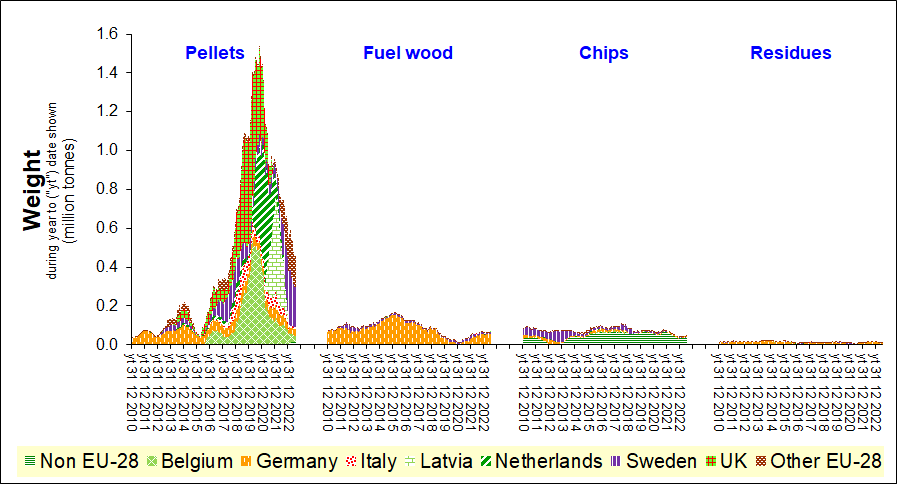
Denmark's exports of pellets, wood fuel, chips and wood residues
Source: based on
Eurostat (CN8, monthly,
codes 440131,
44011*, 44012*, other 4401*) to 31 07 2025
Remarks: the great majority of the pellets reported as exports
by Denmark are probably re-exports, not least
because the leading destination countries for those pellets report
negligble quantities of pellets as imports from Denmark (home to a
leading trader).
Wood pellets
One of the EU's leading suppliers of wood pellets has recently been
declared bankrupt and there are allegations that its interests in
pellet manufacturing in the USA were fraudulent.[-]
The group's bankruptcy jeopardised proposals to convert the Langerloo
power station (in Belgium) to use biomass fuel (which has now ceased
burning coal[-]
until that power station was acquired by Graanul Invest (based in
Estonia), which claims
to be the biggest producer of wood pellets in Europe.[-]
There is little public information about the ownership and financing
of the group. The group indicates that its pellets derive from the
by-products of saw mills in Estonia, Latvia and Lithuania.[-]
The discrepancy between the weight of pellets exported to the UK
from Latvia and the weight of pellets imported by the UK from Latvia
is sufficiently large and persistent to warrant explanation by Drax and the SBP (which,
being largely controlled by Drax and major
electricity generating companies, has a clear conflict of interest as
a scheme which certifies its owners supplies of pellets). The
discrepancy also warrants liason between the customs services of
Latvia and the UK, and their compatriots in Competent Authorities under the EU's "Timber Regulation" (given
that fraud might be a leading explanation). None of the Baltic States
imports substantial quantities of wood pellets from Russia
and/or Belarus.
One of the power stations which have been awarded large subsidies
from the UK government[Slide
6] has yet to be built. Its main contractor[-][-]
is currently subject to bankruptcy proceedings[-]
This will presumably delay[-]
not only the project's financial close[-][-],
but also the commencement of construction (now expected Q2 2017[-]).
The contractor's bankruptcy would have jeopardises the proposed
construction of a 215MW power station in Belgium, but a replacement
contractor has been appointed.[-][-].
The sole supplier of wood pellets to that power station[search
term MGT] would seem to be linked to an enterprise against which a
formal complaint has been made to the USA's Securities and Exchange
Commission[-].
That complaint alleges misrepresentation of evidence provided to
investors.
According to a
statement by its
developer, greenhouse gas emissions of the Teesside power station are capped at
a level roughly five times less than those of a coal-fired power
station of the same capacity. This is so unlikely that investors
and officials should question why that statement has been made.
Given that the power station's fuel, wood (in the form of pellets
and/or chips) emits at least as much CO2
on combustion as coal per unit of calorific value, such a cap on its
emissions would implicitly cap the power station's output, in turn
capping the power station's potential revenue to roughly five times
less than if it were coal-fired.
The developer also states that
the power station will save a substantial quantity of CO2
during its life,[-]
as does its financial adivser[footnote
ii].
However, power stations do not sequester CO2
and sustaining cheap electricity supplies tends to promote consumption
(- typically and for the time being, of products having a
signigificant greenhouse gas footprint). Further, as is the
convention amongst those who promote the generation of electricity
from biomass, that purported saving assumes that biomass burned in
power stations does not emit CO2.
The requirement that its wood fuel will derive from sources which
are sustainably managed will severely constrain the supply of that
fuel. Very little woodland in south eastern USA is certified as
being sustainably managed. Given that the structure of woodland
ownership is highly fragmented and given that owners are subject to
minimal regulation - particularly in relation to sustaining the nature
of that land - there is little assurance that certified woodland will
remain eligible (and there is a risk that if that woodland is not
already a plantation, it will be cleared in order to become one,
fundamentally changing the nature of that land).
Suggested
reading:
"Burning
wood from Southern US forests to generate electricity in Europe"
(letter from US Scientists to the EC 08 2013)
"Forest
Bionergy for Europe - What science can tell us" EFI (2014)
"Review
of literature on biogenic carbon and life cycle assessment of forest
bioenergy" Forest research (05 2014)
"State
of play on the sustainability of solid and gaseous biomass used for
electricity, heating and cooling in the EU" EC (2014)
"Carbon
Emissions and Climate Change Disclosure by the Wood Pellet Industry –
A Report to the SEC on Enviva Partners LP" Partnership for Policy
Integrity and Dogwood Alliance (03 2016)
"Woody
Biomass for Power and Heat: Impacts on the Global Climate" D Brack
for Chatham House (02 2017)
|

























